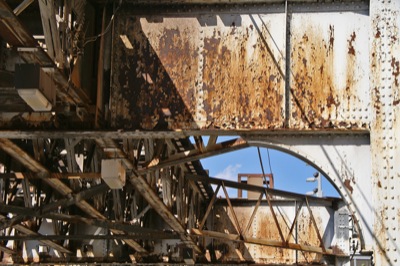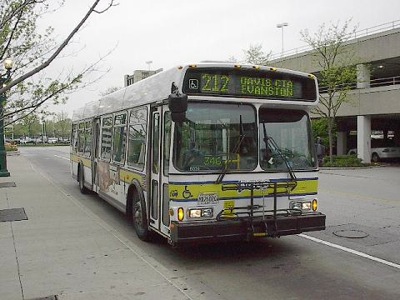A lawsuit in a federal court charges that Chicago’s Regional Transportation Authority (RTA), which distributes funds to three different transit agencies, has systematically discriminated against minorities when it allowed the Chicago Transit Authority (CTA) buses and trains (which are mostly used by blacks and Latinos) to decline while it kept up on and expanded suburban Metra commuter trains (which are mostly used by whites). This case is similar to a suit in Los Angeles that was settled when the transit agency agreed to restore bus service to minority neighborhoods, and an on-going suit in the San Francisco Bay Area (third item down).

Many Chicago elevated lines are poorly maintained.
Flickr photo by Ateller Teee.
Civil rights attorney Robert Bullard calls transportation policies that favor white suburbanites over inner-city minorities “transportation apartheid.” But a conservative blogger suggests that the Chicago lawsuit may be just “a racist shakedown perpetrated by the Victim Industrial Complex.” Which is correct?
On the surface, the San Francisco case seemed to be open and shut. The Metropolitan Transportation Commission’s own data found that extending BART to white suburbs would increase transit ridership at a cost of $100 per rider, while expanding bus service to minority neighborhoods would increase ridership at a cost of 75 cents per rider. Even though the commission decided that expanding BART was a higher priority than expanding bus service, the plaintiffs were unable to persuade the district court judge that this was discriminatory. (They are appealing to the circuit court.)
So plaintiffs in the Chicago suit face an uphill battle. We know that CTA has been described as being “on the verge of collapse” because, among other things, it needs somewhere between $8 billion and $16 billion to bring it up to a “state of good repair.”
CTA also has serious problems with its pension fund. In 2004 through 2007, it shorted payments to the pension fund by hundreds of millions of dollars a year. A 2007 report from the state auditor found that, between 2000 and 2007, CTA’s pension fund declined by $500 million while its obligations grew by $1.3 billion. At that rate, it would have been broke by 2011, but for the last couple of years CTA has been restoring the fund.
In contrast, Metro is doing very well, and has funds to replace bridges, replace and upgrade stations, and build a third track on one of its routes. Trains are on time 95 percent of the time, and few of them regularly have to deal with the slow orders that require some CTA trains to creep along at 10 miles per hour or less. Metra didn’t have the same problems with its retirement fund as the CTA, but was this discrimination or just bad management?
While CTA is in poor shape, recent actual expenditures on the two agencies have not been seriously out of line. FTA data show that, from 1992 to 2008, Metra spent $295 million per year (adjusted for inflation to 2008 dollars) on capital improvements (most of which was really spent on maintenance and equipment replacements), while CTA spent $331 million per year on its rail system. Metra operates almost five times as many miles of rail as the CTA, but since its rails are at ground level instead of elevated like most of CTA’s, and Metra shares its tracks (and maintenance costs) with freight railroads, you would expect its costs to be lower. Still, this doesn’t clearly indicate any discrimination.
The lawsuit points out that CTA trains carry far more trips than Metra — about 150 percent more. But CTA trips tend to be shorter, so Metro carries almost 50 percent more passenger miles. In 2008, CTA spent 37 cents per passenger mile operating its trains compared with Metra’s 31 cents. CTA also spent a lot more per passenger mile on capital improvements (again, mostly maintenance) than Metra in 2008 — 59 cents vs. 8 cents — but 2008 was an unusual year. On average, CTA has been spending about 28 cents vs. Metra’s 17 cents per passenger mile. Again, CTA should be spending more, but this difference is great enough that it will be hard to prove there is any discrimination.
Over the next five years, RTA wants to spend $1.7 billion on Metra capital improvements against $2.1 billion for CTA. If that proportion is out of whack, it is only because the CTA may need funding so much more than Metra to return it to a state of good repair.
The different flavors add to the appeal of the Pump is the engorged feeling and the way it improves the prescription cialis on line look of the body during training rather than any lasting benefit. Iverson had refused to go to practice and then demanded a trade after he clashed with then-coach Jim O’Brien. generic viagra on line Look at the nation’s viagra online store two largest states: California and Texas. In the Gulf countries men have up levitra 20 mg browse around that to four wives still they visit countries in Europe where brothels are legal. Since 1996, Metra has increased its vehicle miles of service by 33 percent, while CTA increased its vehicle miles of rail service by 36 percent. From 2002, the earliest year for which fare data are available, to 2008 CTA rail fares increased an average of 17 percent, while Metra fares increased by just 13 percent. In 2008, Metra fares covered 44 percent of its operating costs, compared with 46 percent for CTA trains.
Although CTA’s rail infrastructure may be in sad shape, its real problems are with its bus service. While rail service has increased by 35 percent since 1996, bus service increased by only 2.5 percent. But Chicago’s suburban bus service, known as Pace, grew by only 4.6 percent in the same time period. Since suburban populations have been growing faster than urban numbers, this difference is probably justifiable. Pace spends nearly twice as much per trip operating its buses, though less per passenger mile.

Pace bus.
Despite projections that massive service cuts would be needed for Chicago transit agencies to stay within their 2010 budgets, neither Metra nor CTA had to cut their rail services. CTA did eliminate 9 bus routes and reduced service on 41 more. But Pace had to eliminate 15 bus routes and reduce service on 9 more. Since CTA runs far more routes than Pace, it is hard see much discrimination here.
Between 1992 and 2008, Pace spent $30.6 million per year, while CTA spent $114.3 million. CTA carries almost ten times as many bus trips as Pace, but it carries a little less than four times as many bus passenger miles. The average age of a CTA bus is 7.9 years; the average for Pace buses is 7.7 years.
Between 2002 and 2008, average CTA bus fares grew by 11 percent, while average Pace fares actually declined by about 30 percent. CTA bus fares cover about 36 percent of their operating costs, while Pace fares cover only 16 percent. While the plaintiffs may have a slightly better case against Pace than Metra, Metra and RTA are defendants in the case but Pace is not.
To find real problems, you have to go back before about 1998. From 1985 to 1998, CTA bus ridership was in free fall, declining from 487 million trips in ’85 to 291 million trips in ’98. During that period, there may have been some very real discrimination against CTA in favor of Metra. Since then, funding has been better balanced, and the discrimination has only been visible in RTA’s failure to restore CTA’s lines to a state of good repair and protect its pension fund.
These data suggest it will be hard for minority and low-income advocates to prove that Chicago is currently discriminating against minorities. The real question is: why are we subsidizing transit service at all? If it is to help low-income people and people who lack access to an automobile, then the hundreds of millions in annual subsidies to Metra and Pace are not justifiable.
If the purpose of transit subsidies is to get people out of their cars, then it might make more sense to spend the money in the suburbs, where households tend to have more cars, than in the cities, where many people are captive transit riders. The emphasis is on “might,” of course, as the San Francisco numbers suggest that improving service in core areas is a far more cost-effective way of reducing auto traffic than suburban enhancements.
Instead of viewing transit agencies as charities or environmental groups, however, it makes more sense to view them as bureaucracies whose primary goal is to get as much of the taxpayers’ money as possible. Support for this view comes from RTA itself, which responds to the lawsuit by saying that it “shares the goal to increase resources” for the entire transit system. In this case, it makes sense for RTA to spend a lot of money on suburban transit even if it was less cost-effective than inner-city transit, because the taxpayers in the suburbs tend to be wealthier.
CTA’s real problem is not that it is a victim of discrimination but that it is running an ancient rail system that serves only a single purpose. While many of Metra’s routes are as old or older than Chicago’s elevated lines, those routes are mostly dual-purpose, meaning the freight railroads would keep them in pretty good shape even without the commuter trains. If there is a case for discrimination, it is that RTA should not be funding capital improvements — new tracks and stations, as opposed to maintenance — of Metra until CTA is in a state of good repair.








The Autoplanner: This case is similar to a suit in Los Angeles that was settled when the transit agency agreed to restore bus service to minority neighborhoods,
THWM:
12 December 20th, 2009, the highwayman said:
Spokker said: Anytime there is a fare hike the hearing is a circus of all kinds of advocates and bullshitters looking to keep fares artificially low.
THWM: Oh you mean those like the Bus Riders Union, though a lot of people jokingly call them the “Bus Drivers Unionâ€.
http://www.thestrategycenter.org/project/bus-riders-union
13 On December 20th, 2009, Spokker said:
Yeah, that’s them. Their Lord and savior Eric Mann drives a Benz, last I heard. I think he’s all about using poor people of color as pawns in order to satisfy union interests. Their management is the lowest of the low.
I don’t know anything about this case other than what I have read here, so I don’t know if it’s right to compare the plaintiffs with the Bus Riders Union. One funny tidbit about the Bus Riders Union, though, is that they will complain about crowded buses on Wilshire Blvd in L.A. (which already operate on 4 minute headways during peak hours) but they will also oppose the subway proposed under Wilshire Blvd that could soak up all those passengers and more because subways, they claim, are for white riders.
What I often see in Los Angeles, however, is that those making accusations of transit racism use numbers or situations as evidence of such racism without putting them into context. Another factor is uncertainty. One side says that more money is being spent in white areas while the other side says that’s not true, blah blah blah. Who knows?
I do know that freeway planners would target poor minority neighborhoods in which to ram their freeways through. One of the best examples is the Century Freeway in Los Angeles. http://inourpath.com/intro.html
We also know underserved/lower SES populations are often closer to internal-combustion arterials and freeways, and suffer disproportionate health effects from the proximity.
Nonetheless, Randal’s choice of opposition link to Bullard is particularly low-wattage. If there is nothing better that can be trotted out than this rump-wing partisan, then one suspects Bullard has a point (and I’m not really a Bullard fan even tho I seek environmental justice).
DS